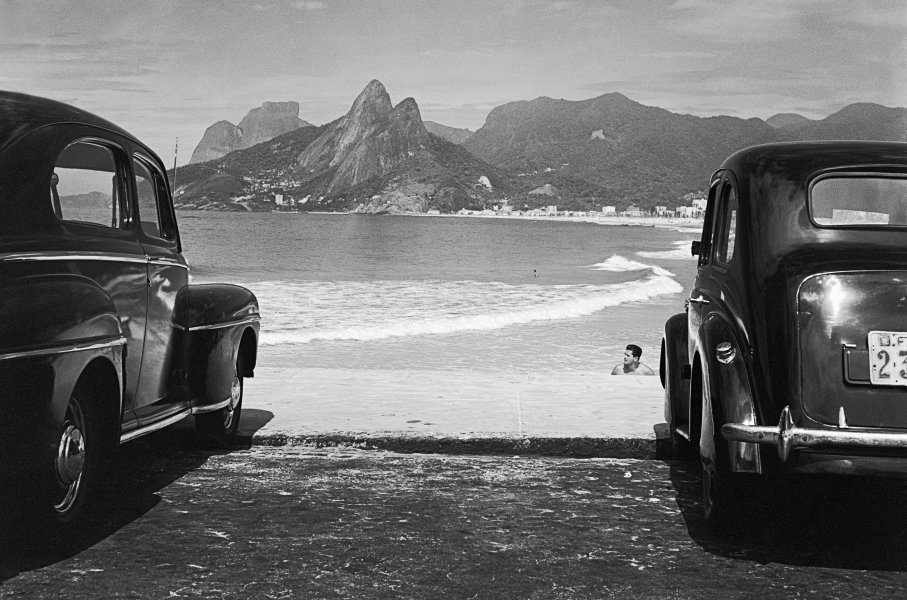Modernities: Brazilian Photography (1940-1964)
Curatorship: Samuel Titan Jr., Ludger Derenthal and António Pinto Ribeiro
21 Feb 2015 - 10:00 – 19 Apr 2015 - 18:00
Galeria de Exposições Temporárias, Piso -1
Admission 3 €
An exhibition from The Instituto Moreira Salles Collection, coproduced by and the Staatliche Museen zu Berlin, the Gulbenkian Programme Next Future and the French Branch (where the exhibition will be held from 5 May until 26 July 2015). Photographs by José Medeiros, Thomaz Farkas, Marcel Gautherot and Hans Gunter Flieg, from the Instituto Moreira Salles.

© José Medeiros. A pedra da Gávea, o morro dos Dois Irmãos e as praias de Ipanema e do Leblon, Rio de Janeiro, 1952
In this major exhibition at the Calouste Gulbenkian Foundation (within the Gulbenkian Next Future Programme), four exemplarily chosen photographers capture Brazil's path to modernism. Three of the photographers were European émigrés: Thomaz Farkas was Hungarian, Marcel Gautherot came from France, and Hans Gunter Flieg was born in Germany. Their foreign roots only underscore Brazil's international appeal in the years after the Second World War up to the beginning of the Brazilian military dictatorship in 1964.
José Medeiros is remembered as the country's classic photojournalist of the forties and fifties. His photo-stories for the leading Brazilian illustrated O Cruzeiro captured life in Rio de Janeiro, on the beach, and at Carnival, as well as the social events and rituals of the upper ten-thousand. Contrasted to this are his picture-stories from the inland. They show the onset of technology in the world of the Indians and the magical cult of the Candomblé.
From early on familiar with the style of the European New Vision or Neues Sehen, Thomaz Farkas applied the austere look to his studies of form when he was still just a teenager, in his depictions of the Estádio do Pacaembu, or other iconic buildings of the 1940s in São Paulo. As a leading member of the Foto Cine Clube Bandeirante, his body of work represents the search for ever-new visual languages. In his later years, he managed to transfer his form-conscious photographic style to a more strongly photojournalistic one, evident for instance in his panoramic shots of the construction of the new capital Brasília. These photographs were only recently rediscovered in preparations for this exhibition.
As an outstanding representative of the photo-essay, Marcel Gautherot was the man behind the lens of numerous iconic shots in Brazilian photography. His pictures of folk rituals and festivals, in the jungle and among the fisherman of Belém are carefully composed studies that hold narrative and visual impact in perfect balance. This style made him the ideal chronicler of Brasília's construction. His photographs of Oscar Niemeyer's buildings, which were in themselves designed to have a strong visual impact, have come to shape our perception of this apotheosis of Brazilian modernism.
In his industrial photographs, Hans Gunter Flieg recorded the process of industrialization in Brazil. Often specific commissions, his pictures are classic pictorial interpretations of the reshaping the country through the rise of technology. Photographs of factory interiors, of engineering structures such as power plants rest alongside photographs of trade-fair stands and industrial products. His photography was the photography of the common man, meant in the best possible sense, a style that was internationally established and understood.
The archives of the four photographers are kept in the Instituto Moreira Salles (IMS), one of the leading private foundations for the promotion of culture in Brazil. With its cultural centres in São Paulo, Rio de Janeiro, and Belo Horizonte, it opens up broad horizons on Brazilian music, the visual arts, film, literature, and photography. More than any other institution, it is responsible for preserving the national photographic legacy of Brazil in its entire breadth and variety and has become renowned both in Brazil and abroad for the numerous exhibitions and publications it promotes.
